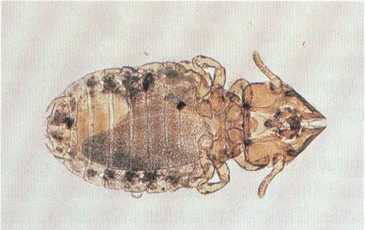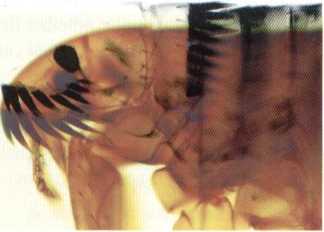310 (14)

3 : Ectoparasitic skin diseases
Table 3:2: Identification of the principal inseds involved in feline skin disease.
(Techniques diagnostiques en dermatologie des camivores, Bourdeau P (editor Guaguere E.) pp 43-58 (PMCAC Editions, Paris 1991)

Cat.
Beige with transverse brownish bands on the abdomen - 1 mm -wingless.
Large pentagonal head, truncated at the tip.
3-part antennae, slender legs.
Figurę 3 : i : Felicola subrostratus (adult) (x40) (courtesy of ENV Parasitology Laboratory, Lyon)

Figurę 3 : j: Felicola subrostratus nit (xl25) (courtesy of D.N. Carlotti)
FLEAS
Ctenocephalides spp.
Cat, dog, various mammals and sometimes man. Brownish.
1-3 mm - rounded head with no frontal tubercle - thorax well developed. Presence of 2 combs (ctenidia), one a horizontal comb on the head (genal comb) and the other on the prothorax (pronotal comb).
Ctenocephalides felis
Head elongated in the female - 9 spines on the genal comb 5-6 notches on the tibia of leg III.
Ctenocephalides canis
Head rounded in both sexes - 8 spines on the genal comb, the first one much smaller- 8 notches on the tibia of leg III.

Figurę 3 : k : Ctenocephalides felis (x40)
Pulex irritans
Man, sometimes cat, dog and various mammals.
Brownish - 1-4 mm - rounded head with no frontal tubercle - thorax well-developed - no combs (ctenidia)
1 sub-ocular bristle and 1 post-ocular bristle, both well-developed - 1 row of spines on the abdominal segments.
Archaeopsylla erinacei
Hedgehog, rodents, mustelids (weasel faniily), cat.
Brownish - 2-3 mm - short head with no frontal tubercle - thorax well-developed - 2 short spines.
Spilopsyllus cuniculi
Rabbit, sometimes hair, fox, mustelids, cat.
Brownish - 1-2 mm - angular head on the upper side - thorax welI-developed - 2 combs - genal comb is oblique with 4-7 blunt spines, 2 ocular bristles.
Echidnophaga gallinacea
Birds, dog, cat, various other mammals.
Brownish - 1-1.5 mm - head at a slight angle with a well-developed occipital lobe - palps with one segment - laciniae strongly toothed - thorax short (less than the length of the first abdominal segment).
Wyszukiwarka
Podobne podstrony:
35 (267) A Practical Guide to Feline Dermatology 1 3 Table 3:1: Identification of the principal
3 AN UNPUBLISHED DOCUMENT AB OUT THE GREEK REYOLUTTON 723 Another important element for the ide
220 G G FLORESCU 14 the Porte m certain internat problems of the Principalities,67 Prince Cuza
of both sides of the ID card (passport or other document confirming the identity of the shareholder;
14 Joanna Rakowska Fig. 5. Fig. 5. Ranking of voivodships by their share in total EU funding obtaine
56 L. Berkowski 56 L. Berkowski Table 1. Comparison of the resulls of superplastic deformation at th
136 (<J>CBMR+Msuin)P(-)> table 5.3). Analyses of the covariate effects revealed that within
75 (196) 5 THE FINGERS 5.1 THERAPY GUIDE The muscles which may restrict movements of the fingers are
Lab 7 Assignment 3: presentation and assessment of results 2 Lab 8 Assignment 4: identification of
Acta Mineralogica-Petrographica, Abstract Series 4, Szeged, 2004MAGNETIC IDENTIFICATION OF THE MAGNE
15 Table 1 Ratio of the number of people becomlng unemployed to the total number of employed and une
4Metale w nawozach TABLE 9.6 Levels of the Heavy Elements in Primary Sources Added to Agriculture La
Motivation system to work in disposable group. Case study 203 Table 1. Characterisation of the popul
155 Demir, B., A. Haberal, P. Geyik, B. Baskan, E. Ozturkoglu, O. Karacay et S. Deveci (2008). Ident
więcej podobnych podstron